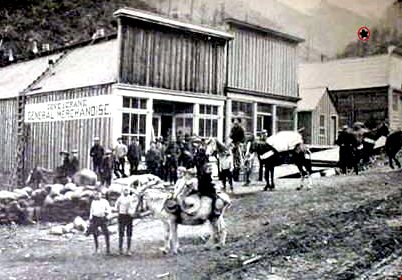 |
| (Click image to enlarge) |
In February-March 1892 Soapy Smith was in control of silver boom-town Creede, Colorado. John W. Postgate a senior reporter for the
Chicago Herald came to Creede for a firsthand article on the new camp. Soapy introduced himself to John and no doubt gave a first rate tour of the camp with introductions to its leading citizens, including Soapy good friends and associates, John P. Kinneavy and "Bat" Masterson. Some time after returning to Chicago and publishing the article Soapy sent John a couple of letters. Below is the return response from John Postgate.
My dear Smith:
Just returned from Minn and find two letters from you. I will see the business manager tomorrow about 25 copies daily for two months. I will communicate with you directly. I am glad that the articles sided the camp, and that you are all still on the boom. I don’t know what you mean by “The cave of the cliff dwellers.” I had no notes on anything of the sort. If it is anything good get someone to write it and forward me. Regards to Keneavy [sic], Masterson & others.
Yours truly,
John W. Postgate
[On the rear John wrote]
Should you come across anything interesting at any time would be pleased to hear. J.W.P.
 |
Photo found in Neely's history of the Parliament of religions and
religious congresses at the World's Columbian Exposition
By F.T. Neely, (Edited by Walter R Houghton) 1894.
(Click image to enlarge) |
John W. Postgate was born in England, August 10, 1851. He studied reporting in London, making it his career. He came to the United States in 1874 where he began working for American newspapers such as the Chicago Inter-Ocean and the Chicago Tribune. I located the information about his impressive newspaper reporting career in the
Who’s who in New York City and State, Issue 3 by Lewis Randolph Hamersly page 1056.
 "Bat" Masterson
February 17, 2011
December 26, 2010
August 21, 2010
May 25, 2010
April 13, 2010
March 12, 2010
October 30, 2008
John Kinneavy
January 6, 2011
December 30, 2010
September 16, 2010
September 16, 2010
June 27, 2010
October 21, 2009
March 18, 2009
"Bat" Masterson
February 17, 2011
December 26, 2010
August 21, 2010
May 25, 2010
April 13, 2010
March 12, 2010
October 30, 2008
John Kinneavy
January 6, 2011
December 30, 2010
September 16, 2010
September 16, 2010
June 27, 2010
October 21, 2009
March 18, 2009

: page 74, 80, 84, 97, 103, 173, 176, 219, 223-25, 232, 419, 422-24, 435, 443.
John Kinneavy: page 73, 95-96, 104, 133-34, 149-50, 154, 160-61, 172-73, 191, 201, 203, 207-08, 214, 218, 226, 232, 245, 248, 376, 388, 594.
Jeff Smith
.

































